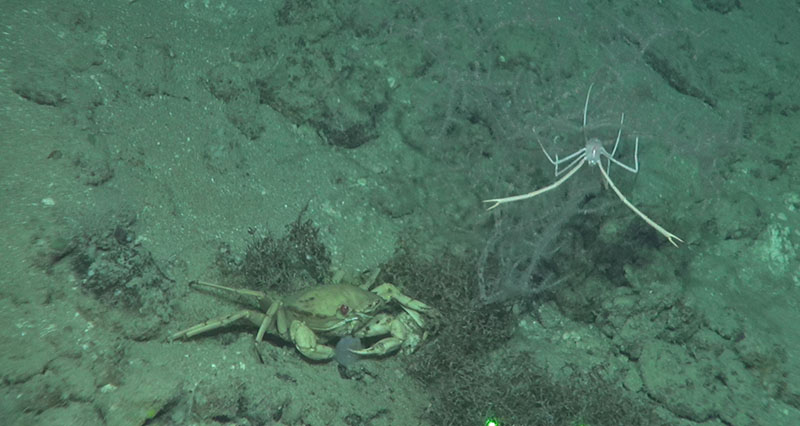
By Morgan Kilgour, Gulf of Mexico Fishery Management Council,
Heather Coleman, NOAA Deep Sea Coral Research and Technology Program
August 15, 2017

Squat lobster Eumunida picta hanging out under a carbonate ledge at 450 meters depth on Long Mound of the West Florida shelf. Image courtesy of NOAA Southeast Deep Coral Initiative and Pelagic Research Services. Download larger version (jpg, 1 MB).
Squat lobsters are commonly seen in the deep sea, and their characteristic claws-up pose is often a welcome sight for researchers searching for coral communities. Some species are found all across the seafloor, others on soft sandy sediment, some near or on deep-sea corals, and others prefer nooks and crannies carved out of ledges or walls. They are the photo-bombers of the deep!
On this mission around the West Florida shelf aboard NOAA ship Nancy Foster, we have observed a type of squat lobster known as a chirostyloid throughout our dives with the remotely operated vehicle (ROV) Odysseus. Eumunida picta is a common, brightly colored chirostyloid that frequently alerts us to nearby coral habitat.
On our expedition, we have found this species picking culinary treasures out of passing currents, and we even snapped a picture of one that appeared to delicately excavate the scraps of a newly molted shell. E. picta have been observed sharing a meal of squid, a benefit in an environment where food is scarce and catching such a prize may be a rare event.

Squat lobster Eumunida picta dining out of another E. picta’s shell at 450 meters depth on Long Mound of the West Florida shelf. Image courtesy of NOAA Southeast Deep Coral Initiative and Pelagic Research Services. Download larger version (jpg, 628 KB).
Observations like this naturally lead researchers to ask more questions. Do these creatures normally share food, or is this sighting a rarity? When observations about life in the deep are limited to snapshots by a vehicle unnaturally lighting a dark environment, we must ask if a specific behavior is normal.
On many dives we have observed a small fish that so far appears to live primarily on some corals, sometimes along with a chirostyloid squat lobster (see photo to the right). When associated with corals, these squat lobsters are usually found near the top of the colony. The fish tend to be upside down near the base, in the coral branches. Are they using coral as a perch to grab bits of food out of the water? Do the fish or squat lobster provide any benefit to the coral? In French Polynesian tropical reefs, a cousin crab species defends its coral host from the voracious crown-of-thorns seastar. Are we observing similar protections being provided by squat lobsters to their coral hosts? Testing these questions in a deep-sea environment is challenging.

Corals Lophelia pertusa (white, center) and Paramuricea sp. (yellow, center-right) with associated fish Benthocometes sp. (center) and Eumunida picta (top) at 430 meters depth on Long Mound of the West Florida shelf. Image courtesy of NOAA Southeast Deep Coral Initiative and Pelagic Research Services. Download larger version (jpg, 1 MB).
Other squat lobsters, like some galatheoids, are found on soft sediment and in burrows. Soft sandy bottoms are not common targets for deep-sea exploration. However, we do know that these squat lobsters are commonly found in the stomachs of tilefish, making them an important ecosystem contributor as a prey item.

Chirostyloid (squat lobster) on black coral Leiopathes sp. with golden crab Chaceon fenneri at 410 meters depth on Long Mound of the West Florida shelf. Image courtesy of NOAA Southeast Deep Coral Initiative and Pelagic Research Services. Download larger version (jpg, 843 KB).
On every dive, with every observation, our knowledge grows along with our list of questions. Answering these questions takes dedication and patience, and an outstanding crew like the one we have here on NOAA Ship Nancy Foster.
The expedition is supported by NOAA’s Deep Sea Coral Research and Technology Program through the Southeast Deep Coral Initiative (SEDCI), a multi-disciplinary effort that will study deep-sea coral ecosystems across the Southeast United States in 2016-2019.